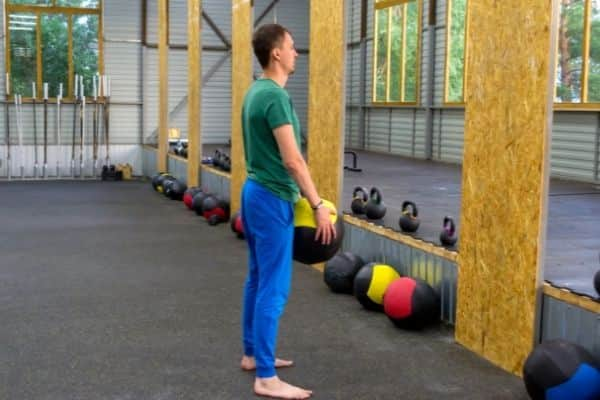No. Plyometrics are very intense exercises that are designed to produce maximum power in the shortest possible time, so it’s best to take 24 hours between plyometric workouts. Muscles need at least 24 hours to recover and some people may need up to 72 hours of rest before their muscles will be ready for another high-intensity workout like plyometrics.
Why plyometrics is not recommended as Daily Workout?
Lets see some reasons of why plyometrics should not be done every day:

- Plyometric exercises are very intense and involve a lot of fast twitch muscle fibers which need time to recover.
- The connective tissue (tendons, ligaments and cartilage) needs at least 24 hours between plyo workouts to heal and strengthen. You can’t strengthen connective tissue in much less than 24 hours. To make this tissue stronger you need to move up in progressive overload and volume.
- There is a point of diminishing return on plyometric training. If you do too much, your nervous system will start shutting down muscle fiber recruitment because it’s working so hard to recruit more fibers than necessary for the exercise. This means that one workout with maximal power output would be more beneficial than five workouts with sub-maximal power output.
- There is a very real danger of injury if you do plyometrics too often. Most injuries occur when the muscles and connective tissue are not fully recovered from the previous workout, so it’s important to take at least 24 hours between sessions.
So in conclusion, plyometrics should not be done every day because they are very intense and involve a lot of fast-twitch muscle fibers which need time to recover. The connective tissue (tendons, ligaments, and cartilage) also needs at least 24 hours between plyo workouts to heal and strengthen. There is a point of diminishing return on plyometric training, so it’s best to do just one or two workouts per week. There is also a very real danger of injury if you do plyometrics too often, so it’s important to take at least 24 hours between sessions.
Explore Benefits of Plyometrics…
- Become Taller with Plyometrics – No, you are not going to grow any taller by doing exercises that target your muscles. But , it can assist, checkout how?
- Build Muscles with Plyometrics – Checkout article for plyometrics exercises and benefits of it for building muscles.
- Plyometrics for Long Distance Runners – Plyometric exercises are designed to increase speed, but not for runners who are looking to add distance to their runs. Check it for more information.
- Increase Speed With Plyometrics – Plyometrics is used to improve the speed and agility of an individual. Check out the actual processes and exercises that benefit you greatly.
Possible injuries during plyometrics
If you are interested to take up plyometrics as are daily workout and fully devoted to getting results, then you should consider listening to your body. As too excessive workout can result in injury. Here are the possible injuries associated with plyometrics Workout;
1. Knee Joint Injury
During plyometrics workout, if your knee or foot slips while jumping, you can easily hurt your knees and ankles. This injury may be very serious in individuals with pre-existing knee problems, so it is important to review any symptoms that occur before doing workouts involving jumps.
2. Shoulder injuries
Plyometric exercises that involve throwing and catching can increase the risk for shoulder injuries. These exercises require a lot of force to be applied through the shoulder joint, so it is important to warm up properly and use caution when starting these exercises.
3. Hamstring Injury
Hamstring injuries are very common in athletes and can occur when the hamstrings are asked to produce too much force during plyometrics. If you have a history of hamstring problems, it is wise to avoid doing the exercises that may cause this type of injury.

4. Stress fracture
Stress fractures in the legs and feet are another possible risk when performing high-impact plyometric workouts. To give your bones enough time to recover, it is important to take at least one day of rest between plyometric workouts.
5. Ankle Sprain
The ligaments that support the ankle can be easily injured when doing plyometrics exercises. If you are not careful when performing these exercises, you can easily sprain your ankle.
6. Wrist injury
If your hands slip while catching or throwing, you can sprain your wrist. To reduce the risk of this type of injury, make sure to keep your wrists straight when catching and throwing. Also, grip the ball tightly when performing throws.
Browse More on Plyometrics…
- Does Plyometrics Work? – No. Plyometrics are intense exercises that are there to produce power, and we shared some of the reasons why it’s not recommended as a daily workout.
- Is it okay to do Plyometrics Everyday? – No. Plyometrics are intense exercises that are there to produce power, and we shared some of the reasons why it’s not recommended as a daily workout.
- Plyometrics and Cardio are Same? – Yes! Plyometrics can be a form of cardio. They can be considered cardio if done at high intensity. To know more, checkout article.
- Plyometrics makes you bulky!!! – Plyometric training alone won’t assist you to gain muscles. We think it’s the opposite. Check out the article to find out why!!!
- Injuries with Plyometrics – It is possible but rare. These workouts are meant to be done by people who are either fit and healthy. Find out more in article.
What is the best type of plyometrics workout?
The best type of plyometrics workout is one that includes a variety of jumping moves, such as jumping jacks, hops, and jumps down from a step. Because these moves recruit muscles from different parts of the body, they will improve your overall fitness level and prevent musculoskeletal injuries.
How many times should you do a plyometric workout per week?
It should not be done every day because they are very intense and involve a lot of fast-twitch muscle fibers which need time to recover. The connective tissue (tendons, ligaments, and cartilage) also needs at least 24 hours between plyo workouts to heal and strengthen. There is a point of diminishing return on plyometric training, so it’s best up to do just one or two workouts per week.
How long does it take to see results from plyometrics?
Typically it takes around six weeks of plyometric training or about 20 hours of work to start seeing results such as improved coordination and an easier time doing everyday tasks.
Conclusion
Plyometrics are intense exercises that require a lot of energy to do. To get the most out of your plyometric training, you need to take at least 24 hours between workouts because it’s very demanding on muscles and joints. You also want to make sure you’re doing just one or two per week so you don’t overdo it.
Plyometrics will help with fat burning by increasing muscle mass and calorie expenditure for an extended period after exercise is finished. They can also improve coordination, strength, endurance levels as well as bone health due to their high impact.






